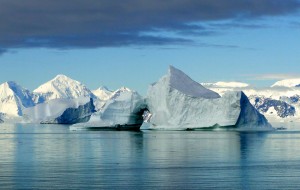1 December 2014
Mixing waters up in the Southern Ocean
Posted by Nanci Bompey
By Elinor Elis-Williams

Scientists returned to the Antarctic Peninsula aboard RRS James Clark Ross earlier this year to deploy an EM-Apex float in the hope of observing more tidal mixing processes.
Credit: Jess Mead Silvester
The Southern Ocean encircles Antarctica and plays a key role in controlling the global climate. It is here that ocean currents return from the abyss to the surface, closing the global ocean overturning circulation. This circulation drives the poleward transport of heat, which is critical to the relatively mild weather in the United Kingdom.
New research has for the first time identified a new process that contributes to this upwelling of abyssal water, a key component of the global overturning circulation.
The research, published online in Geophysical Research Letters, a journal of the American Geophysical Union, presents the first direct evidence of a hypothesized mechanism that enables the transport of deep waters to the surface over the Antarctic continental slope.
“The ocean interior is stratified, with surfaces of constant density separating the layers of water. In the Southern Ocean, strong winds cause these density surfaces to incline, tilting upwards towards Antarctica. It has long been known that the slow, upward diffusion of waters along these density surfaces is unable to account for all upwelling here. It had been hypothesized that another mechanism – the mixing of heat and mass across these density surfaces- might provide a shortcut,” explains Bangor University Ocean Physics PhD student Jess Mead Silvester, lead author of the new paper.
“In fact, we observed very high levels of mixing across the density surface that generally separates the upwelling branch of the global overturning circulation from waters that have already been exposed to the surface and which are on their way northwards. This means that waters are short-cutting the longer route via the surface,” she said.
“We believe that the interaction of tidal currents with the sea bed on the steep continental slope provided the energy driving the mixing. We think that this process may be occurring over as much as 30 percent of the Antarctic continental slope, making a significant contribution to the upwelling, and hence the strength of the global overturning circulation,” Mead Silvester said.
“Our ability to predict the strength of ocean overturning and its impact on climate is hindered by poor representation of the mixing processes that facilitate the water mass transformations that drive it,” said Yueng-Djern Lenn, a research fellow at Bangor University and a co-author of the new study. “Jess’s work is of particular significance because it challenges the Southern Ocean paradigm by presenting new evidence of a process that is currently missing in our representation of Southern Ocean mixing. Our results further highlight the continental slope regions as being important players in overturning, and the need to take time-series measurements when attempting to resolve intermittent turbulent mixing processes.”
— Guest blogger Elinor Elis-Williams is a press officer at Bangor University. This post first appeared as a press release on the Bangor University website.











 GeoSpace is a blog on Earth and space science, managed by AGU’s Public Information staff. The blog features posts by AGU writers and guest contributors on all sorts of relevant science topics, but with a focus on new research and geo and space sciences-related stories that are currently in the news.
GeoSpace is a blog on Earth and space science, managed by AGU’s Public Information staff. The blog features posts by AGU writers and guest contributors on all sorts of relevant science topics, but with a focus on new research and geo and space sciences-related stories that are currently in the news.